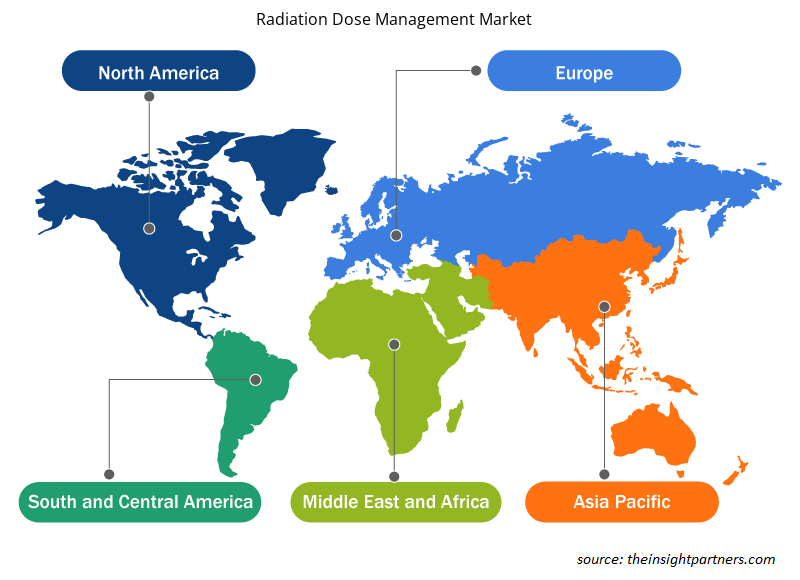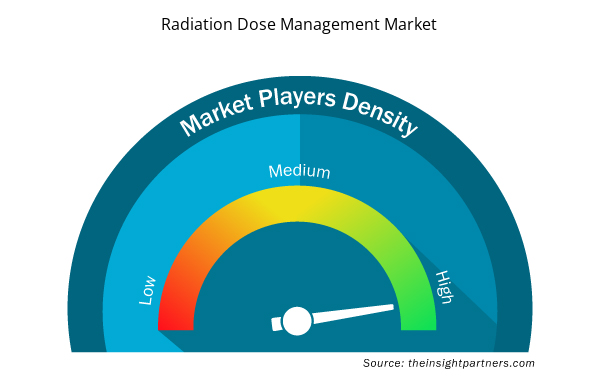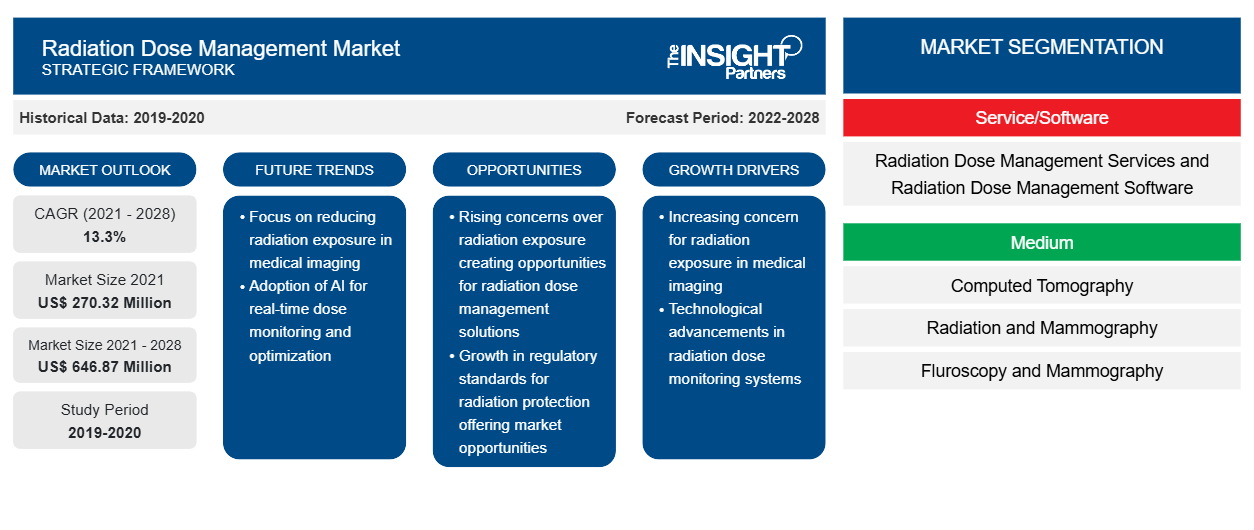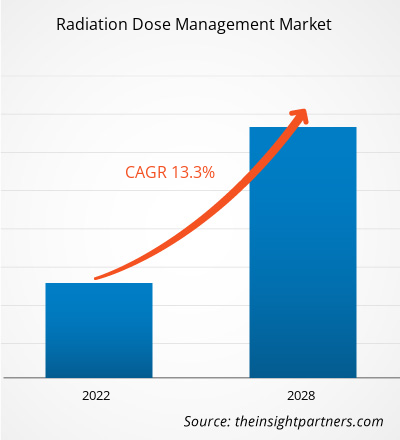Se proyecta que el mercado de gestión de dosis de radiación alcance los 646,87 millones de dólares en 2028, desde los 270,32 millones de dólares en 2021; se estima que crecerá a una CAGR del 13,3 % durante 2021-2028.
La radioterapia es una rama esencial de la ciencia médica. Diversas enfermedades, como el cáncer, las enfermedades cardiovasculares, etc., se diagnostican y tratan mediante ondas electromagnéticas. Se utiliza ampliamente para tratar diferentes tipos de cáncer. Sin embargo, la radioterapia también tiene efectos secundarios. Por lo tanto, controlar la dosis de radiación correcta es muy esencial en cualquier procedimiento médico basado en la radiación. La dosis de radiación es la cantidad de radiación que se aplica al paciente. La gestión de la dosis de radiación comprende información sobre el software de registro de la dosis de radiación; el control de la dosis por parte del personal en tiempo real; el cumplimiento normativo; y las tecnologías de reducción de dosis, como el software de reconstrucción interactiva.
El crecimiento del mercado de gestión de dosis de radiación se atribuye a las crecientes preocupaciones relacionadas con la exposición a la radiación y el aumento de los casos de cáncer que requieren radioterapia. Sin embargo, los desafíos organizativos y la falta de evaluación comparativa para la optimización de la dosis obstaculizan el crecimiento del mercado.
Personalice este informe según sus necesidades
Obtendrá personalización en cualquier informe, sin cargo, incluidas partes de este informe o análisis a nivel de país, paquete de datos de Excel, así como también grandes ofertas y descuentos para empresas emergentes y universidades.
- Obtenga las principales tendencias clave del mercado de este informe.Esta muestra GRATUITA incluirá análisis de datos, desde tendencias del mercado hasta estimaciones y pronósticos.
Perspectivas del mercado
Creciente atención a la radiología intervencionista y la medicina nuclear
Los rápidos avances en la tecnología médica, la fabricación de dispositivos y los equipos de diagnóstico por imagen han dado como resultado el refinamiento de los procedimientos originales con mejores técnicas y una expansión de las indicaciones para los procedimientos. Se han desarrollado nuevas técnicas y algunas técnicas se han migrado a otras modalidades de diagnóstico por imagen. Debido a la alta eficiencia de la obtención de imágenes, se están realizando más procedimientos de radiología intervencionista y medicina nuclear en todo el mundo. Según la Sociedad de Medicina Nuclear, cada año se realizan aproximadamente 20 millones de procedimientos de medicina nuclear en los EE. UU. Según lo informado por la Asociación Nuclear Mundial, más de 10 000 hospitales en todo el mundo utilizan radioisótopos en medicina y el 90 % de los procedimientos con radioisótopos son diagnósticos. Los actores del mercado como Bayer Healthcare y Sectra Medical Systems ofrecen software de gestión de dosis específicamente para RDM en imágenes intervencionistas y medicina nuclear. Por lo tanto, el creciente enfoque en la radiología intervencionista y la medicina nuclear está brindando oportunidades para el crecimiento del mercado.
Información basada en software y servicios
Según el servicio/software, el mercado global de gestión de dosis de radiación se ha segmentado en servicios de gestión de dosis de radiación y software de gestión de dosis de radiación. El segmento de software de gestión de dosis de radiación tuvo la mayor participación del mercado en 2021 y se prevé que registre una CAGR del 13,6 % en el mercado durante el período de pronóstico.
Perspectivas basadas en el medio
Según el medio, el mercado mundial de gestión de dosis de radiación se segmenta en tomografía computarizada, radioterapia y mamografía, fluoroscopia y mamografía, y otros medios. El segmento de tomografía computarizada tuvo la mayor participación del mercado en 2021 y se prevé que registre una CAGR del 13,8 % en el mercado durante el período de pronóstico.
Perspectivas regionales del mercado de gestión de dosis de radiación
Los analistas de Insight Partners explicaron en detalle las tendencias y los factores regionales que influyen en el mercado de gestión de dosis de radiación durante el período de pronóstico. Esta sección también analiza los segmentos y la geografía del mercado de gestión de dosis de radiación en América del Norte, Europa, Asia Pacífico, Oriente Medio y África, y América del Sur y Central.

- Obtenga datos regionales específicos para el mercado de gestión de dosis de radiación
Alcance del informe de mercado sobre gestión de dosis de radiación
| Atributo del informe | Detalles |
|---|---|
| Tamaño del mercado en 2021 | US$ 270,32 millones |
| Tamaño del mercado en 2028 | US$ 646,87 millones |
| CAGR global (2021-2028) | 13,3% |
| Datos históricos | 2019-2020 |
| Período de pronóstico | 2022-2028 |
| Segmentos cubiertos | Por servicio/software
|
| Regiones y países cubiertos | América del norte
|
| Líderes del mercado y perfiles de empresas clave |
|
Densidad de actores del mercado de gestión de dosis de radiación: comprensión de su impacto en la dinámica empresarial
El mercado de gestión de dosis de radiación está creciendo rápidamente, impulsado por la creciente demanda de los usuarios finales debido a factores como la evolución de las preferencias de los consumidores, los avances tecnológicos y una mayor conciencia de los beneficios del producto. A medida que aumenta la demanda, las empresas amplían sus ofertas, innovan para satisfacer las necesidades de los consumidores y aprovechan las tendencias emergentes, lo que impulsa aún más el crecimiento del mercado.
La densidad de actores del mercado se refiere a la distribución de las empresas o firmas que operan dentro de un mercado o industria en particular. Indica cuántos competidores (actores del mercado) están presentes en un espacio de mercado determinado en relación con su tamaño o valor total de mercado.
Las principales empresas que operan en el mercado de gestión de dosis de radiación son:
- Corporación FUJIFILM Holdings
- Bayer AG
- Bracco Imaging SpA
- Atención sanitaria de GE
- Philips NV, la línea Koninklijke
Descargo de responsabilidad : Las empresas enumeradas anteriormente no están clasificadas en ningún orden particular.

- Obtenga una descripción general de los principales actores clave del mercado de gestión de dosis de radiación
Información basada en el usuario final
Según el usuario final, el mercado de gestión de dosis de radiación está segmentado en hospitales, institutos médicos y de investigación, entre otros. El segmento hospitalario tuvo la mayor participación del mercado en 2021 y se estima que registrará la CAGR más alta del mercado, del 13,6 %, durante el período de pronóstico.
Los lanzamientos y aprobaciones de productos son estrategias que las empresas suelen adoptar para ampliar su presencia global y sus carteras de productos. Además, los actores del mercado de gestión de dosis de radiación se centran en la estrategia de asociación para ampliar su clientela, lo que, a su vez, les permite mantener su marca en todo el mundo.
Perfiles de empresas
- Corporación FUJIFILM Holdings
- Bayer AG
- Bracco Imaging SpA
- Atención sanitaria de GE
- Philips NV, la línea Koninklijke
- Plaza médica
- Corporación Novarad
- QAELUM INC
- Sectra AB
- PACSSalud, LLC
- Análisis histórico (2 años), año base, pronóstico (7 años) con CAGR
- Análisis PEST y FODA
- Tamaño del mercado Valor/volumen: global, regional, nacional
- Industria y panorama competitivo
- Conjunto de datos de Excel



Report Coverage
Revenue forecast, Company Analysis, Industry landscape, Growth factors, and Trends

Segment Covered
This text is related
to segments covered.

Regional Scope
North America, Europe, Asia Pacific, Middle East & Africa, South & Central America

Country Scope
This text is related
to country scope.
Preguntas frecuentes
The Radiation Dose Management software segment dominated the global radiation dose management market and held the largest revenue share of 77.67% in 2021.
Radiation dose management involves services and software that keep records of the radiation doses, real time dose monitoring, regulatory compliance. It is an information technology which is considerate in lowering the dose with integrative reconstruction software. The software assists to find the right way to radiation dose for a patient to get treated by the integration of medical technology and insightful data & services.
Key factors that are driving the growth of this market are growing concerns related to radiation exposure, and rising cases of cancer demanding radiation therapy.
The Computed Tomography segment dominated the global radiation dose management market and held the largest revenue share of 42.54% in 2021.
The hospitals segment dominated the global radiation dose management market and accounted for the largest revenue share of 51.14% in 2021.
Global radiation dose management market is segmented by region into North America, Europe, Asia Pacific, Middle East & Africa and South & Central America. In North America, the U.S. is the largest market for radiation dose management. The market growth in the country is attributed to the factors such as the stringent legislative and accreditation requirements regarding the reporting and optimization of radiation doses, high adoption of HCIT technologies, and the presence of stringent regulatory requirements regarding patient safety. And, North America is the fastest-growing region growing at the CAGR of 13.8% during the forecast period.
The radiation dose management market majorly consists of the players such as FUJIFILM Holdings Corporation; Bayer AG; Bracco Imaging S.p.A; GE Healthcare; Koninklijke Philips N.V.; Medsquare; Novarad Corporation; QAELUM INC; Sectra AB; PACSHealth, LLC: among others.
Trends and growth analysis reports related to Technology, Media and Telecommunications : READ MORE..
List of Companies - Radiation Dose Management Market
- FUJIFILM Holdings Corporation
- Bayer AG
- Bracco Imaging S.p.A
- GE Healthcare
- Koninklijke Philips N.V.
- Medsquare
- Novarad Corporation
- QAELUM INC
- Sectra AB
- PACSHealth, LLC
The Insight Partners performs research in 4 major stages: Data Collection & Secondary Research, Primary Research, Data Analysis and Data Triangulation & Final Review.
- Data Collection and Secondary Research:
As a market research and consulting firm operating from a decade, we have published and advised several client across the globe. First step for any study will start with an assessment of currently available data and insights from existing reports. Further, historical and current market information is collected from Investor Presentations, Annual Reports, SEC Filings, etc., and other information related to company’s performance and market positioning are gathered from Paid Databases (Factiva, Hoovers, and Reuters) and various other publications available in public domain.
Several associations trade associates, technical forums, institutes, societies and organization are accessed to gain technical as well as market related insights through their publications such as research papers, blogs and press releases related to the studies are referred to get cues about the market. Further, white papers, journals, magazines, and other news articles published in last 3 years are scrutinized and analyzed to understand the current market trends.
- Primary Research:
The primarily interview analysis comprise of data obtained from industry participants interview and answers to survey questions gathered by in-house primary team.
For primary research, interviews are conducted with industry experts/CEOs/Marketing Managers/VPs/Subject Matter Experts from both demand and supply side to get a 360-degree view of the market. The primary team conducts several interviews based on the complexity of the markets to understand the various market trends and dynamics which makes research more credible and precise.
A typical research interview fulfils the following functions:
- Provides first-hand information on the market size, market trends, growth trends, competitive landscape, and outlook
- Validates and strengthens in-house secondary research findings
- Develops the analysis team’s expertise and market understanding
Primary research involves email interactions and telephone interviews for each market, category, segment, and sub-segment across geographies. The participants who typically take part in such a process include, but are not limited to:
- Industry participants: VPs, business development managers, market intelligence managers and national sales managers
- Outside experts: Valuation experts, research analysts and key opinion leaders specializing in the electronics and semiconductor industry.
Below is the breakup of our primary respondents by company, designation, and region:

Once we receive the confirmation from primary research sources or primary respondents, we finalize the base year market estimation and forecast the data as per the macroeconomic and microeconomic factors assessed during data collection.
- Data Analysis:
Once data is validated through both secondary as well as primary respondents, we finalize the market estimations by hypothesis formulation and factor analysis at regional and country level.
- Macro-Economic Factor Analysis:
We analyse macroeconomic indicators such the gross domestic product (GDP), increase in the demand for goods and services across industries, technological advancement, regional economic growth, governmental policies, the influence of COVID-19, PEST analysis, and other aspects. This analysis aids in setting benchmarks for various nations/regions and approximating market splits. Additionally, the general trend of the aforementioned components aid in determining the market's development possibilities.
- Country Level Data:
Various factors that are especially aligned to the country are taken into account to determine the market size for a certain area and country, including the presence of vendors, such as headquarters and offices, the country's GDP, demand patterns, and industry growth. To comprehend the market dynamics for the nation, a number of growth variables, inhibitors, application areas, and current market trends are researched. The aforementioned elements aid in determining the country's overall market's growth potential.
- Company Profile:
The “Table of Contents” is formulated by listing and analyzing more than 25 - 30 companies operating in the market ecosystem across geographies. However, we profile only 10 companies as a standard practice in our syndicate reports. These 10 companies comprise leading, emerging, and regional players. Nonetheless, our analysis is not restricted to the 10 listed companies, we also analyze other companies present in the market to develop a holistic view and understand the prevailing trends. The “Company Profiles” section in the report covers key facts, business description, products & services, financial information, SWOT analysis, and key developments. The financial information presented is extracted from the annual reports and official documents of the publicly listed companies. Upon collecting the information for the sections of respective companies, we verify them via various primary sources and then compile the data in respective company profiles. The company level information helps us in deriving the base number as well as in forecasting the market size.
- Developing Base Number:
Aggregation of sales statistics (2020-2022) and macro-economic factor, and other secondary and primary research insights are utilized to arrive at base number and related market shares for 2022. The data gaps are identified in this step and relevant market data is analyzed, collected from paid primary interviews or databases. On finalizing the base year market size, forecasts are developed on the basis of macro-economic, industry and market growth factors and company level analysis.
- Data Triangulation and Final Review:
The market findings and base year market size calculations are validated from supply as well as demand side. Demand side validations are based on macro-economic factor analysis and benchmarks for respective regions and countries. In case of supply side validations, revenues of major companies are estimated (in case not available) based on industry benchmark, approximate number of employees, product portfolio, and primary interviews revenues are gathered. Further revenue from target product/service segment is assessed to avoid overshooting of market statistics. In case of heavy deviations between supply and demand side values, all thes steps are repeated to achieve synchronization.
We follow an iterative model, wherein we share our research findings with Subject Matter Experts (SME’s) and Key Opinion Leaders (KOLs) until consensus view of the market is not formulated – this model negates any drastic deviation in the opinions of experts. Only validated and universally acceptable research findings are quoted in our reports.
We have important check points that we use to validate our research findings – which we call – data triangulation, where we validate the information, we generate from secondary sources with primary interviews and then we re-validate with our internal data bases and Subject matter experts. This comprehensive model enables us to deliver high quality, reliable data in shortest possible time.


 Obtenga una muestra gratuita de este informe
Obtenga una muestra gratuita de este informe